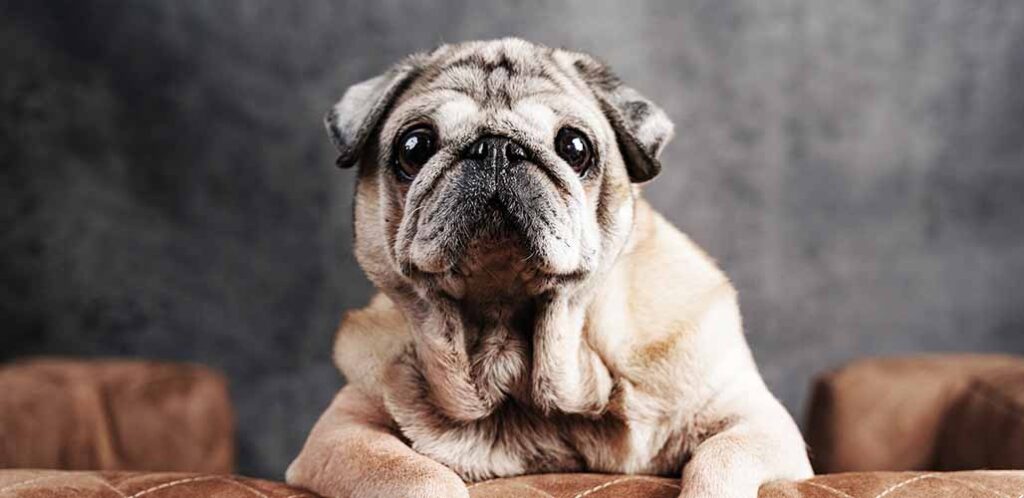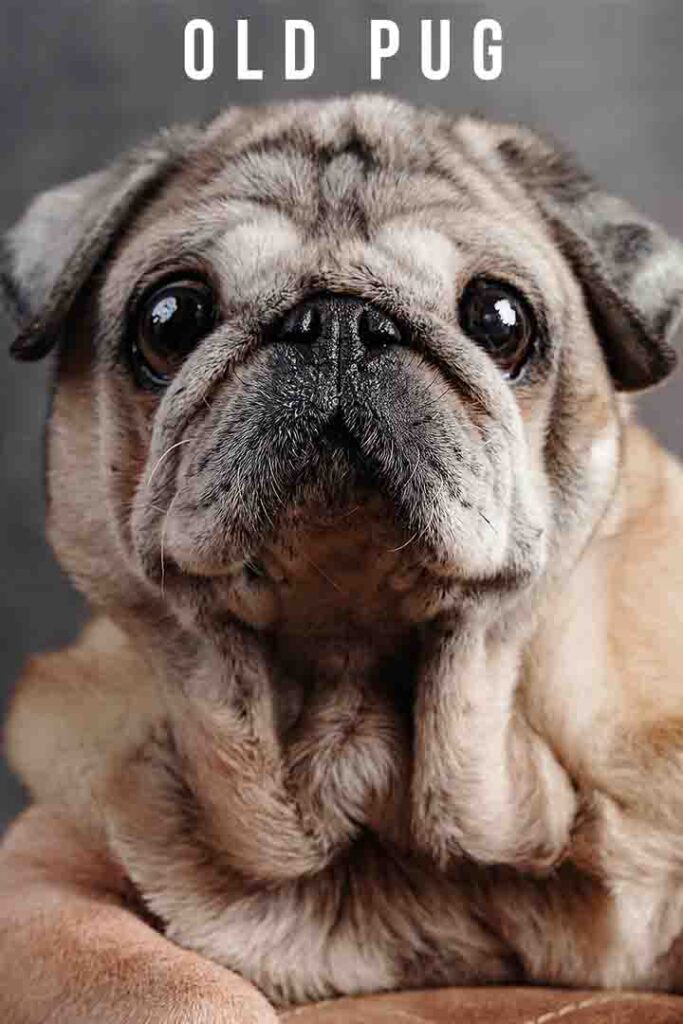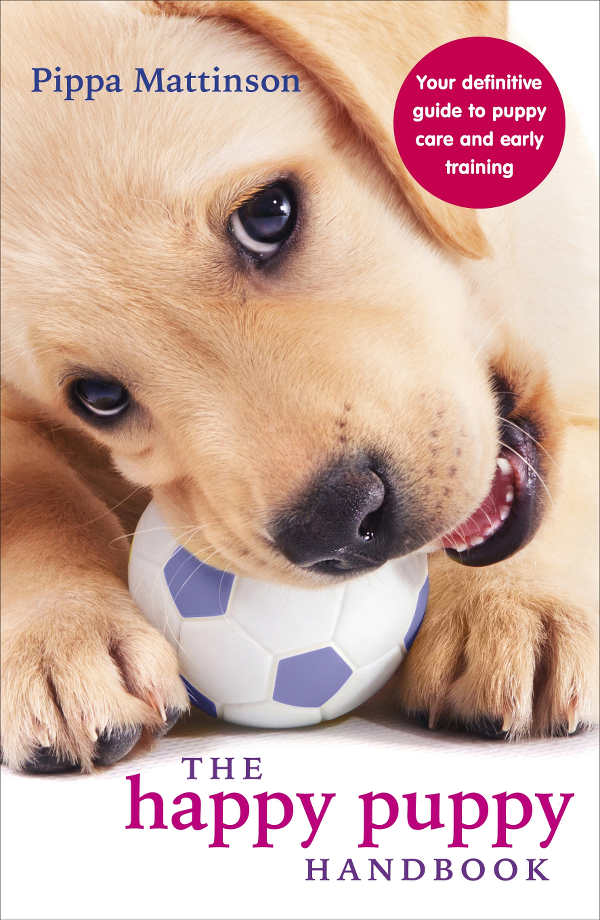
This detailed guide to caring for senior Pugs will help you prepare for life with an old Pug. We’ll look at what age dogs are dogs considered seniors, how you can expect them to change after that point and how best to give them a happy and dignified old age.
- How old do Pugs get?
- When are dogs considered seniors?
- Will my senior Pug change?
- Older Pug health problems
- Caring for an elderly Pug
- 7 year old Pug vs 10 year old Pug
- 10 year old Pug vs 13 year old Pug
- Is searching for senior Pugs for sale a good idea?
An old Pug needs different care from a younger Pug, in terms of diet, exercise, and making your home safe for them. You might also notice their behavior and personality change gradually. Knowing what to expect can help you prepare, and enjoy your Pug’s old age to the maximum.
In this video, Perry the old Pug can be seen enjoying a more gentle pace of life. Let’s take a look at how he has changed from his younger days, and what special age-related care he might need.
How old do Pugs get?
Estimates of the average Pug lifespan, based on records from veterinary clinics, breed clubs, or owner surveys, vary from 10 to 11 years. This is close to but slightly lower than the all-dog average of 11 to 12 years. The oldest individual Pug documented in one of these sources reached a venerable 17 years. But anecdotally, even older Pugs have been reported. For example, according to his owner, Perry in the video above lived to 18 years old.

As a general rule, canine life expectancy goes up as their size goes down. Toy Poodles for example have an average lifespan of nearly 15 years, whilst for St Bernards it is only 7 years. Unfortunately, whilst Pug life expectancy compares well to all dogs on average, it doesn’t look so good compared to other dogs of similar size. In fact, researchers have estimated that Pug life expectancy is 3 to 4 years shorter than for dogs of a similar size. For example, Border Terriers, Lhasa Apso and West Highland White Terriers all occupy the same weight bracket as a Pug, but all live for 14 years, on average.
It’s not that Pugs age faster than those breeds. Sadly it’s because health problems caused by the shape of their head increases the risk of them dying prematurely, and skews the average figures for their life expectancy. We’ll look at that in more detail in a moment, but first, let’s see when a Pug officially becomes old.
When are dogs considered seniors?
Small dogs like Pugs are usually considered senior by their 10th or 11th birthday. But, there are some senior dog adjustments your vet might encourage you to make sooner than that. Such as switching to a senior dog diet at around 7 years old.
Since the average Pug life expectancy is also 10 or 11 years, it sounds like they don’t spend much time in ‘old age’, right? But remember, the average life expectancy includes all the dogs who sadly died prematurely. What we can’t tell from that average is how many Pugs didn’t experience any old age, and how many reached their mid teens, making them seniors for several years. Let’s hope your Pug is one of the lucky ones, and he’s still with you to blow out the candles on his 10th birthday cake. What’s likely to change in him from then on?
Will my senior Pug change?
Dogs experience physical aging just like we do. Common physical changes in old Pugs include:
- Losing pigmentation in their fur
- Getting slower and less agile
- Gaining or losing weight
- Losing muscle mass
- Sensory loss, such as sight loss or hearing loss
Old age itself isn’t a disease, but bits of the body can start to get worn out, and your elderly Pug might also develop some health problems which are more commonly associated with old age. We’ll get to those in a minute. But first, their behavior might change too. For example they might become:
- More set in their ways
- Less playful
- Less tolerant of irritations, such as unwanted attention from children or puppies
- More easily confused
Let’s compare some Pug life stages in closer detail.
7 year old Pug vs 10 year old Pug
The difference between a 7 year old Pug and a 10 year old Pug is, very broadly, similar to the difference between a person in their mid-forties, and a person in their mid-fifties. If they’re not already a little bit gray around the muzzle at 7, they almost certainly will be at 10! Some 10 years old Pugs might have started slowing down a bit too, whilst others are still as dynamic as they ever were.
7 years old is about the milestone when your vet will start recommending switching to a senior diet, and perhaps incorporating supplements for joint health. Senior diets are less calorie dense, so that your dog doesn’t gain weight as they start to get less active. If you haven’t already made this switch at 10 years, it’s definitely time to chat to your vet about it. In other words, it’s a good time to start planning for a healthy old age.
10 year old Pug vs 13 year old Pug
By the time your Pug has aged another 3 years, they are (very roughly) equivalent to a human at 70. At this point it’s fair to describe them as a geriatric Pug, even if your 70 year old uncle wouldn’t appreciate the same label! A 13 year old Pug is very likely to be experiencing some of the physical and behavioral changes associated with old age, and you’ll almost certainly need to make some adaptations in how you care for them. We’ll look at what they might include in a moment, but first let’s look closer at their health.
Older Pug health problems
Besides the general physical changes associated with ages, elderly Pugs are also prone to some additional illnesses.
Older Pug breathing problems
Sadly, Pugs’ shape makes them prone to a lot of health problems which start long before old age. Breeders have succeeded in bringing about dramatic changes in the shape of their jaw and skull bones, so that they have very flat faces. But the soft tissues have not shrunk at the same rate, often causing them to block the airways. At least 1 in 5 of Pugs need veterinary attention for this, but it’s estimated even more Pugs suffer without medical treatment because their owners have been told the symptoms are ‘normal for the breed’. Their flat faces make Pugs more prone to
- noisy and/or labored breathing
- heat intolerance
- sleep apnea
- vomiting
- respiratory tract infections
- and in the worst cases, collapse and death
Older Pugs who haven’t had problems relating to their face shape in the past might start to develop them if they gain weight in their senior years. Immune function also starts to decline in older dogs, which means Pugs are more likely to get respiratory tract infections owing to their face, and more likely to become seriously ill from them due to their age. If you’re worried about older Pug breathing problems, or notice your Pug coughing, consult a veterinarian immediately.
Canine cognitive degeneration
Canine cognitive degeneration (CCD) is also known as doggy dementia, due to its similarity to Alzheimer’s disease in people. It’s estimated that approximately 1 in 7 dogs have some symptoms of CCD by their 8th birthday, and that both the number of affected dogs and the severity of their symptoms increase every year after that. CCD isn’t curable, but some of the care tips in our next section can help manage the anxiety and distress it causes.
Caring for an elderly Pug
If you have an senior Pug approaching their golden years, let’s look at some of the ways you can make sure they’re comfortable as possible:
Choose an appropriate diet
Your Pug can transition to a senior diet any time after their 7th birthday. Their new diet will be less calorie dense, to reflect the fact their becoming less active. There are lots of options available to buy in pet stores and online, including specially shaped kibbles for dogs with flat faces. Depending on the one you choose, your vet might also recommend adding a joint supplement.
Take them for a vet check twice a year
Besides their annual check up and rabies vaccination, it’s a good idea to start taking a senior Pug for mid-year check ups as well. These are an important opportunity to catch any changes which could be causing your Pug pain, or knock unnecessary months off their life.
Keep things consistent
At home, it’s a good idea to keep things as consistent as possible from now on. Try not to change the layout of their home if you can avoid it, and stick to their normal daily routine as often as you can. The older they get, the more distressing and confusing changes can be, especially if they develop CCD.
Help them get around your home
Old Pugs typically become less mobile than their younger days. This includes becoming more prone to injury if they jump up and down from beds and sofas, or use stairs. Think about putting ramps against any soft furniture they use, and putting a gate at the bottom of the stairs so they can’t use them unsupervised.
Rethink their activity
As your Pug ages, they’ll start needing less exercise than they used to. Watch them closely and follow their cues. Some physical activity every day is still vital for keeping them healthy though, but think about switching hikes in warm weather for playing some interactive games together in an air conditioned room.
Respect their space
Finally, old Pugs can start getting less tolerant of being pestered by children or more boisterous dogs. A common symptom of CCD is a gradual emotional withdrawal from their favorite humans as well. This can be hard to take, but it’s important to remember that it’s not personal. Respecting their feelings and letting them have the space they need is the most peaceful and dignified kindness you can offer them.
Is searching for senior Pugs for sale a good idea?
Older dogs surrendered to shelters and rescue dogs are notoriously difficult to rehome. So looking for an older dog to give a comfortable old age to is a noble aim. There are numerous organizations which work solely on rescuing and rehoming Pugs. This is partly because Pugs are popular – there are lots of them, which means the proportion of Pugs in the shelter population is correspondingly large. But it’s also because Pugs’ health problems often end up requiring expensive veterinary care. Which puts them at high risk of being surrendered to a shelter when their owners decide they can’t or won’t pay for them anymore.
Before you commit to an already old Pug, you’ll need to think about how you’ll pay for their veterinary care. Insurance premiums for old dogs tend to be very expensive. But some breed-specific rescue organizations might offer financial help with medical bills. Have a candid chat with them about this when you get in touch.
Old Pug – Summary
Pugs are considered senior from about 10 years old. Unfortunately, Pug’s flat faces reduce their lifespan by approximately 3 years compared to other dogs of a similar size. This means a lot of Pug won’t get an old age. For those that do, there are lots of ways you can make the closing chapters of their life as comfortable and enjoyable as the years before them.
References
Adams et al. Methods and mortality results of a health survey of purebred dogs in the UK. Journal of Small Animal Practice. 2010.
American Veterinary Medical Association
Fick et al. Telomere Length Correlates with Life Span of Dog Breeds. Cell Reports. 2012.
Lui et al. Conformational risk factors of brachycephalic obstructive airway syndrome (BOAS) in pugs, French bulldogs, and bulldogs. PLOS One. 2017.
Packer et al. Come for the looks, stay for the personality? A mixed methods investigation of reacquisition and owner recommendation of Bulldogs, French Bulldogs and Pugs. PLOS One. 2020.
Urfer et al. Lifespan of companion dogs seen in three independent primary care veterinary clinics in the United States. Canine Medicine & Genetics. 2020.

Leave a Reply